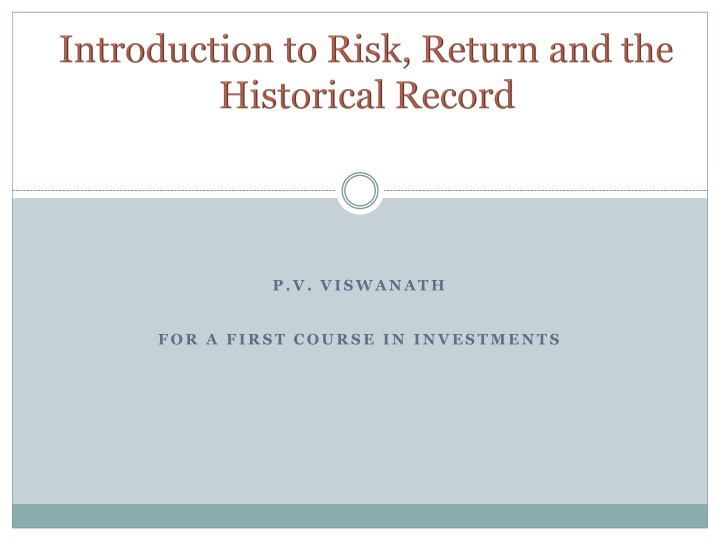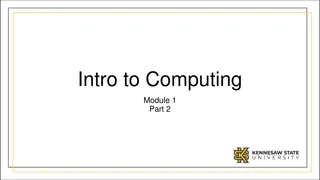
Interest Rates, Risk, and Returns in Investments
Explore how interest rates are determined, how to compare rates of return for different holding periods, the relationship between inflation rates and interest rates, and the analysis of returns in investments. Learn about constructing risk measures and the distinction between nominal and real interest rates.
Uploaded on | 1 Views
Download Presentation

Please find below an Image/Link to download the presentation.
The content on the website is provided AS IS for your information and personal use only. It may not be sold, licensed, or shared on other websites without obtaining consent from the author. If you encounter any issues during the download, it is possible that the publisher has removed the file from their server.
You are allowed to download the files provided on this website for personal or commercial use, subject to the condition that they are used lawfully. All files are the property of their respective owners.
The content on the website is provided AS IS for your information and personal use only. It may not be sold, licensed, or shared on other websites without obtaining consent from the author.
E N D
Presentation Transcript
P.V. VISWANATH FOR A FIRST COURSE IN INVESTMENTS
2 How are interest rates determined? How can we compare rates of return for different holding periods? What is the relation between inflation rates and interest rates? How do we analyze a time series of returns? How do we characterize the distribution of a series of returns? How do we construct risk measures when the probability distribution is not normal?
3 We are interested in determining if there is a relationship between risk and return in US capital markets. If there is one, then it needs to be taken into account in portfolio construction. To do this, we need to define what we mean by return and what we mean by risk. Let s take the notion of return. This is easiest to do when discussing a risk-free security where the investor puts up his money at one point in time and then gets a payoff in the next period. This return is called an interest rate.
4 The real interest rate is the price of access to real resources today as opposed to a point later in time. The nominal interest rate is the price of access to money today as opposed to later. Money, of course, is needed in a money economy to obtain access to real resources. However, the total amount of money can change over time depending upon the actions of the Federal Reserve. If the supply of money increases over time without a change in the amount of goods, then there is a larger amount of money chasing the same amount of goods. As a result prices increase.
5 Investors are interested in return in terms of purchasing power. However, risk-free securities are risk-free only in nominal terms. To compute the return in nominal terms, we need to know the change in the purchasing power of the unit of currency, i.e. the rate of inflation, i. The real rate of return r, is approximately equal to R, the nominal rate of return less the rate of inflation, i. r = R - i
6 Because of this, nominal interest rates are not the same as real interest rates. If we assume that people care about the consumption of real goods, then the markets would be expected to determine the real interest rate. On the other hand, market interest rates are clearly nominal. If so, where are real interest rates determined? One answer is that when nominal interest rates are determined in the market, so are real interest rates. How does this happen? This process is embodied in the Fisher Equation, which says that the nominal interest rate is simply the real interest rate plus the expected inflation rate. This is based on the assumption that the real and nominal sectors of the economy are independent and unrelated. Here s how interest rates are determined according to this approach.
7 The equilibrium real rate of interest is the point at which the Demand Curve for real resources (funds) intersects the Supply curve for (real) loanable funds. The Supply curve consists of the supply of funds from savers, primarily households The Demand for funds consists of the demand from businesses who invest in plant, equipment and inventories (real assets). The government is sometimes a net demander and sometimes a net supplier of loanable funds.
9 Both suppliers and demanders of capital thus determine their supply and demand for capital at different real rates of interest. However, since loan contracts are nominal, they have to contract for a nominal rate of return. To ensure that the resulting real return is consistent with what they are looking for, they forecast the expected inflation rate and add that to the desired real rate of return and then come up with the desired nominal rate of return or nominal rate of interest. In this way, they generate their nominal supply and demand curves.
10 Assuming that investors time preference for real resources do not vary too much over time, changes in the nominal interest rate will simply track changes in the inflation rate. However, this assumes that the inflation rate is easy to predict. Changes in the money supply are the primary determinant of the inflation rate and unfortunately, changes in the money supply can be difficult to forecast. Furthermore, there is a certain amount of money illusion. People think and contract, to some extent, in terms of nominal prices and nominal quantities. As a result, changes in money supply could also have an impact on real quantities. In addition, money is needed as a medium of exchange. Hence it has a real role in the economy, as well. Hence the nominal side of the economy could affect the real economy.
11 If there were complete inflation illusion and the nominal interest rate were constant, the inflation rate would be uncorrelated with the nominal interest rate. On the other hand, if the Fisher Hypothesis held, and if expected real interest rates were relatively constant, then nominal interest rates would move one-to-one with inflation rates. Up to 1967, there seems to have been money illusion, since the correlation of the inflation rate with the nominal T-bill rate was close to zero ( = -0.17). However, since 1968, the correlation has increased ( = 0.64). This suggests that markets are less subject to money illusion. The next graph shows the much closer connection between interest rates and inflation in the post-1967 period.
13 If the Fisher Hypothesis held, and the real interest rate were constant, then the realized real T-bill rate (i.e. nominal minus inflation) should be perfectly negatively correlated with the inflation rate, because any increase in inflation would reduce the realized real rate by an equal amount. R = r + E(i) = r + i + E(i) i or R = r + E(i) = r + i , where = i E(i) is the inflation forecast error; hence R-i = r Why does inflation change over time? In the first instance because of monetary policy; when money growth is low, inflation is low and when money growth is high, inflation is high, all other things being the same. If the Fisher Hypothesis is correct, then the monetary and real sectors are independent, and Corr(r,i) = 0. If inflation forecast errors are not systematic, then the forecast error should be unrelated to the level of inflation, and Corr( i) = 0. Hence the realized real rate should be unrelated to inflation. In other words, when money growth is high, investors will expect inflation to be higher and adjust the nominal rate upwards. As a result, there will be zero correlation between the realized real rate and the inflation rate. However, if there is money illusion, and investors ignore the role of inflation, they will ignore money growth in their determination of the real rate, and the higher the inflation rate, the lower the realized real rate will be because they have not adjusted the nominal rate for the higher inflation. As a result, if there is money illusion, Corr(r-i, i) = -1.0 In practice, this correlation has been about -0.44 after 1967, compared to -1.0 before 1967. This suggests, as we have said before, that there is less money illusion. However, it is not zero, either. That is, nominal rates are not keeping pace with expected inflation. This would happen if real rates and inflation rates were positively correlated. That is, the real and nominal sectors of the economy are connected Corr(r, i) > 0.
14 http://www.crestmontresearch.com/docs/i-rate- history7.xls
15 Arithmetic and Geometric Averages The arithmetic average is the estimated average return over the next one year. The geometric average is the actual yearly return over the next n years, where n is the number of years over which the average is computed. So if we wanted the average annual return over the next five years, how should we compute it?
16 http://www.youtube.com/watch?v=GPDH1e-rxlY Ibbotson and Matthew Rettick Arithmetic and Geometric Averages E(Geom Average) = E(Arith Average) Variance/2 Watch this youtube video and see what s wrong with the arguments made. The next two graphs will show that bond and equity returns are volatile. As a result, it s not sufficient for an investor to simply look at average returns; it s necessary to look at average returns in comparison to volatility.
We have seen that financial portfolio returns are volatile. Investors need to consider the average return in comparison with the risk/volatility of portfolios. The Sharpe Portfolio compares the average return on portfolios over and above the risk-free rate of return as a multiple of the volatility of this excess return. Sharpe Ratio for Portfolios: [E(R)-Rf]/sd(R) Risk Premium = SD of Excess Returns Note that this is not appropriate for individual assets
Investment management is easier when returns are normal. Standard deviation is a good measure of risk when returns are symmetric. If security returns are symmetric, portfolio returns will be, too. Future scenarios can be estimated using only the mean and the standard deviation.
What if excess returns are not normally distributed? Standard deviation is no longer a complete measure of risk Sharpe ratio is not a complete measure of portfolio performance Need to consider skew and kurtosis
Skew Equation 5.19 Kurtosis Equation 5.20 3 _ R 4 _ R R R = skew average = 3 kurtosis average ^ ^ 3 4
26 If return distributions are not asymmetric, then: We should look at negative outcomes separately Because an alternative to a risky portfolio is a risk-free investment vehicle, we should look at deviations of returns from the risk-free rate rather than from the sample average Fat tails should be accounted for LPSD: similar to usual standard deviation, but uses only negative deviations from rf The LPSD is the square root of the average squared deviation, conditional on a negative excess return. However, this measure ignores the frequency of negative excess returns! Sortino Ratio replaces Sharpe Ratio Sortino Ratio = Average excess return/LPSD
A measure of loss most frequently associated with extreme negative returns VaR is the quantile of a distribution below which lies q % of the possible values of that distribution The 5% VaR , commonly estimated in practice, is the return at the 5th percentile when returns are sorted from high to low.
Also called conditional tail expectation (CTE) More conservative measure of downside risk than VaR VaR takes the highest return from the worst cases ES takes an average return of the worst cases This is related to the LPSD
Returns appear normally distributed Returns are lower over the most recent half of the period (1986-2009) SD for small stocks became smaller; SD for long-term bonds got bigger
Better diversified portfolios have higher Sharpe Ratios Negative skew











